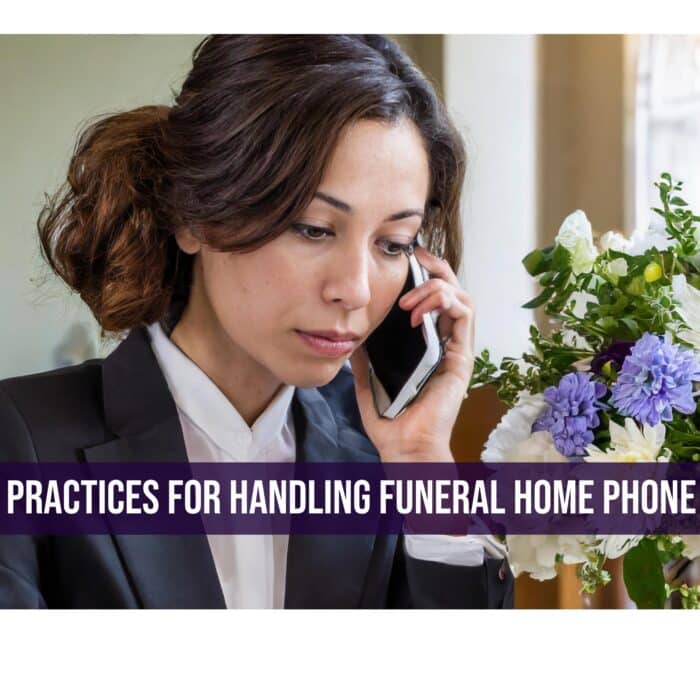May 06, 2021

Originally published in the March/April 2021 issue of the Funeral Business Advisor by ASD Vice President and Family-Member Owner, Kevin Czachor, this article examines the oft-overlooked importance of funeral home web communications. Kevin unpacks revealing data that uncovers how often at-need and pre-need families are sending messages through a funeral home’s website as their first point of contact.
Just a few short years ago, if you had asked any funeral professional what the likelihood was of a family reporting their loved one’s death online, most would have laughed at the question. The possibility of this occurring seemed so unlikely that the vast majority of funeral directors would not waste a second of thought worrying about missing any important queries from their website. Today, without a doubt, this is happening much more frequently, yet many funeral homes still continue to treat their website communication as an afterthought.
The pandemic has led to a major shift in how all businesses interact with the public. In this age of social distancing, a growing number of people are now going online to research different mortuaries and compare options. As a result, information queries sent through funeral home websites are becoming a much more common method families use to get in touch with a funeral professional.

Most funeral home websites have a ‘Contact Us’ form instructing visitors to leave their information and reason for contacting. Funeral professionals would frequently overlook these messages because they were often sent to a single, generic email address that was not monitored 24/7. To address this communication gap, ASD – Answering Service for Directors created Web Form WatchDog™ to help monitor funeral home website inquires and ensure on-call directors were notified immediately when an urgent request was submitted. Since winning the NFDA Members Choice Award in 2018, this tool has been activated on over 1,000 funeral home websites.
In an effort to better understand the impact of web communications on mortuaries, ASD analyzed data on web forms processed within a two-week period. The surprising results confirms just how vital it is for funeral homes to protect their website ‘Contact Us’ page. During the fourteen-day period, 1,330 web forms were processed for 1,000 funeral homes. Of these, 936 were legitimate messages and 394 were spam. When analyzing the legitimate message, it was discovered that 603 were classified as routine, non-urgent messages, 296 were urgent messages and 31 were new death calls.
From this data, one can conclude that on average, two at-need families are reaching out to a funeral home via their ‘Contact Us’ page every day. In reality, the actual number is likely twenty times greater since the data analyzed was based on only 1,000 funeral home websites and there are approximately 20,000 funeral homes in the United States. This means that dozens of at-need families every day will visit a funeral home website and try to connect with them via their ‘Contact Us’ page. How many of those business opportunities end up lost in a spam folder?

For those who might be curious about what type of families might use a funeral home website as their first point of contact, there is no specific answer. These web queries ranged from pricing requests, to questions about transporting bodies to other states or countries, to families asking if their deceased loved one had prearrangements with the mortuary. In some cases, the person indicated in their message they could not receive a phone call and requested an email or text with information.
It is also interesting to note that within the same two-week period, 296 urgent messages were processed in addition to the 31 death notifications. These urgent communications range from preneed inquiries, to time-sensitive questions, to families calling about a loved one’s upcoming service. This averages out to about 21 urgent messages a day, but again the actual number is likely twenty times greater.
This data affirms funeral homes are receiving urgent messages and business opportunities through their website on a regular basis. Yet, many funeral professionals continue to think of their funeral home website as a static advertisement rather than an open channel of communication. Others will invest a great deal of time and money on their website in hopes of receiving more phone calls but fail to account for the potential value of direct website leads. This is a major blind spot mortuary owners must rectify in order to remain competitive in their market and serve their community with the highest level of customer service.

The pandemic has led to major reversal in the way in which the public engages with their local funeral home. The percentage of foot traffic coming into the funeral chapel has decreased considerably due to capacity limitations and society’s avoidance of indoor gatherings. On the flip side of this, funeral homes have more people than ever before visiting their website in order to access online obituaries where they can post condolences to families and access links to live streamed services.
One could argue this change is only temporary and funeral homes will once again regain the foot traffic they had in the past, but waiting out the storm is not a winning strategy. Even as pandemic restrictions are being relaxed, many people have discovered the value of attending funeral services from afar via web streaming and demand for this option is likely to remain. The funeral home website will continue to be the first point of contact for many families in the years to come.

It may seem impersonal or unfamiliar for a funeral home’s relationship with a family to begin online. However, as more businesses adopt this approach, families will come to expect online options from their local funeral home. The younger generations have grown up with the internet and therefore will be expecting it even more. Building a responsive web presence with safeguards in place to ensure urgent messages are communicated immediately is no longer a preference or an option, but a strategic necessity.
Beyond at-need families, web communications should also be a consideration when evaluating the funeral home’s overall approach to customer service. If those with preneed questions or families trying to make changes to a loved one’s obituary don’t hear back from someone after submitting a web request, it can have a snowball effect and severely tarnish the mortuary’s reputation. Remaining vigilant of all incoming messages, including web forms along with other electronic messaging, ensures the funeral home’s commitment to serving the community is never questioned.
Learn More
If you are interested in learning more about ASD’s solutions to help funeral homes monitor their web communications, please contact me at 800-868-99950 or email Kevin@myASD.com.
About the Author

ASD Vice President & Family-Member Owner, Kevin Czachor, has helped develop telecommunication strategies for more than 45 percent of funeral homes in North America. With more than 25 years of experience, Kevin meets with directors regularly to share his expertise on utilizing mobile technology to streamline tasks, enhance communication and increase productivity. Kevin delivers seminars annually on the important connection between communication technology and customer service, focusing on quality control and training. He has also contributed articles on these subjects to many funeral publications.
RELATED READING
ASD’s Web Form WatchDog™ Feature Now Protecting Over 1,000 Funeral Home Websites
ASD Quick Tip Video Series: Protect Your Funeral Home Website with Web Form WatchDog™
Why Funeral Home Technology Programs Need to Speak the Same Language
About The Author
Jess Farren (Fowler)
Jess Farren (Fowler) is a Public Relations Specialist and Staff Writer who has been a part of the ASD team since 2003. Jess manages ASD’s company blog and has been published in several funeral trade magazines. She has written articles on a variety of subjects including communication, business planning, technology, marketing and funeral trends. You can contact Jess directly at Jess@myASD.com



